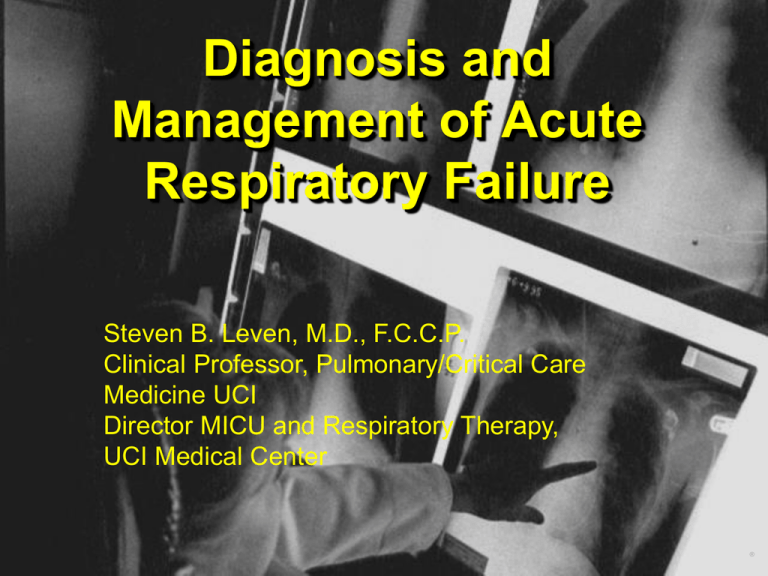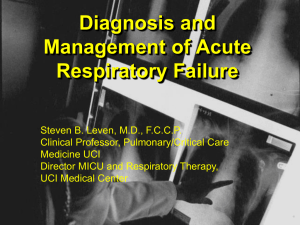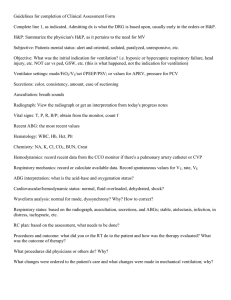Diagnosis and Management of Acute Respiratory Failure
advertisement

Diagnosis and Management of Acute Respiratory Failure Steven B. Leven, M.D., F.C.C.P. Clinical Professor, Pulmonary/Critical Care Medicine UCI Director MICU and Respiratory Therapy, UCI Medical Center 1 ® Objectives • Understand the causes of hypoxia and • • • • • hypercapnea Know the clinical manifestations of respiratory failure Be familiar with various oxygen delivery systems Know indications and contraindications to noninvasive positive pressure ventilation Know indications for endotracheal intubation Be familiar with basic modes of mechanical ventilation 2 CASE # 1 J.T. is a 68-kg, 42-yr old female admitted after a drug overdose complicated by emesis and aspiration. Intubation and mechanical ventilation are initiated in the emergency department. 3 CASE # 1 • Mechanical ventilation – AC (volume) mode – Tidal volume 750 mL – 16 breaths/min – FIO2 1.0 – PEEP 5 cm H2O 4 CASE # 1 • • • • • • Peak airway pressure 52 cm H2O Inspiratory plateau pressure (IPP) 48 cm H2O pH 7.38, PaCO2 36 PaO2 57 Sinus tach at 166, BP 75/50, no urine output Patient very “agitated” and “fighting vent” What would you do? 5 CASE #2 L.W. is a 62-yr-old, 52-kg female with severe emphysema. For 2 days she has had progressive dyspnea and was found unresponsive. ABG on 5liters NC pH 7.07 pCO2 87 pO2 62. She required intubation and initiation of mechanical ventilation. 6 CASE #2 ICU ventilator settings • AC, rate 12 breaths/min • Tidal volume 500 mL • FIO2 100% • PEEP 5 cm H2O 7 CASE #2 • • • • • • • • • • RR 24 I:E ratio = 1:1.5 Peak pressure 50 cm H2O, IPP 35 cm H2O End expiratory pressure is 20 cm pH 7.20, PaCO2 60, PaO2 215 Sinus tach 157 BP 78/45 No urine output Patient very agitated What would you do? 8 CASE #3 • 37 year old healthy malpractice plaintiff attorney presents to ER with 24 hour history of generalized weakness. Last week he had a mild bout of gastroenteritis after eating under cooked chicken. He could walk with difficulty when he arrived at ER 8 hours ago. Now he needs help to reposition himself in bed and he coughs when he attempts to drink. 9 CASE #3 • Exam normal • • • • except weakness Chemistries and CBC normal RA ABG pH 7.41 pCO2 41 pO2 84 Vital Capacity 840cc (12cc/Kg) CXR at left 10 CASE #3 • Where should this patient be cared • • • • for? ICU? Tele? Ward? Home? Should this patient be fed? Should he be advised to call a lawyer? Would you put him on BiPAP? Anything else you would do? 11 Case # 4 • A 25-year-old lady, Miss. Poor Compliance, is rushed into your Emergency Department. She is an asthmatic who on arrival is sitting forward in the tripod position, using her accessory muscles to breath. She is tachypneic, diaphoretic, agitated and unable to talk. During a nebulizer tx with albuterol she becomes dusky and poorly responsive. 12 Case # 4 13 Plan of care? • Get ABG? • Start BiPAP? • Discuss patient’s “feelings” about being ill? • Get advice from resident (oops, he is running a code) • Other? 14 Acute Respiratory Failure • Hypoxemic –Room air PaO2 50 torr • Hypercapnic –PaCO2 50 torr • Acute vs chronic • Often Multifactorial ARF 15 Pathophysiology of Hypoxemia • Ventilation/perfusion mismatch • Shunt effect (intracardiac or intrapulmonary) • Decreased diffusion of O2 • Alveolar hypoventilation • FIO2 < 21% (eg. High altitude) ARF 16 16 Pathophysiology of Hypercapnia • Alveolar ventilation is the prime determinant of CO2 exchange during mechanical ventilation • VA ~ 1/pCO2 • VA=(VT-VD)f • Change in any variable affects pCO2 17 Causes of Hypercapnia • Inability to sense elevated PaCO2 • Inability to signal respiratory muscles • Inability to effect a response from respiratory muscles • Increased dead space 18 Inability to effect adequate response from respiratory muscles • Imbalance between demand for respiratory muscle work and the ability to supply that work • Examples of increased demand: bronchospasm, fever, low lung compliance, pleural effusion • Decreased supply: poor cardiac output, malnutrition, deconditioning 19 Increased Dead Space (wasted ventilation) • • • • • Hypovolemia Low cardiac output Pulmonary embolus High airway pressures Short-term compensation by increasing tidal volume and/or respiratory rate 20 Manifestations of Respiratory Distress • Altered mental status – especially anxiety!!! • • • • Anxiety is a result of respiratory distress, almost NEVER the cause. Increased work of breathing – Tachypnea, nasal flaring – Accessory muscle use, retractions, paradoxical breathing pattern, respiratory alternans Catecholamine release – Tachycardia, diaphoresis, hypertension Abnormal ABG – not always!!! Neuromuscular failure is different from above – monitor vital capacity – intubate near 15cc/kg 21 Oxygen Supplementation low flow systems 1-10 LPM • 100% O2 mixes with room air to determine FIO2 - • definition FIO2 varies with patient’s breathing pattern – – – – Rapid inspiration entrains more room air Deep breaths entrain more room air Rapid respiratory rate entrains more room air Patients in more distress get lower FIO2 • FIO2 is unknown since amount of entrainment is • • unknown Any humidity in gas comes from entrained air- wall O2 has 0% relative humidity Low flow devices Simple Nasal Cannulas Simple masks 22 High Flow O2 Devices > 20 - 60 lpm • • • • • Device provides 100% of gas to patient - definition No entrainment of room air if mask fits FIO2 is known and exact Relative humidity depends on the device High flow devices: – High flow nasal cannula – Venturi mask – Aerosol mask – heated or cool – Nonrebreather mask – some characteristics of both high and low 23 O2 Devices 24 Aerosol O2 devices 25 BiPAP or NPPV • Contraindications – Cardiac or respiratory arrest – Inability to cooperate, protect the airway, or clear • • • • secretions – Nonrespiratory organ failure, esp shock – Facial surgery, trauma, or deformity – Prolonged duration of mechanical ventilation anticipated – Recent esophageal anastomosis A need for emergent intubation is an absolute contraindication to NPPV Set inspiratory pressure (IP) and exp pressure (PEEP) Mean pressure determines oxygenation IP – PEEP determines ventilatory assist 26 Endotracheal Intubation “….An opening must be attempted in the trunk of the trachea, into which a tube or cane should be put; You will then blow into this so that lung may rise again….And the heart becomes strong….” -Andreas Vesalius (1555) 27 Indications for Endotracheal Intubation • Airway protection (outside ICU?) • Relief of airway obstruction • Respiratory failure or impending • • • respiratory failure – Hypoxic or – Hypercapneic or both Need for hyperventilation - ICP Unsustainable work of breathing Facilitate suctioning/pulmonary toilet • Shock !!!!!!!!!!! 28 Decision to intubate • • • • • • Clinical decision-not based on ABG Error on the side of patient safety What is the safest way to navigate illness? Intubation is not an act of weakness Think ahead- if need to intubation is expected in next 24hr, intubate now Endotracheal tubes are not a disease and ventilators are not an addiction i.e. Intubation does not cause ventilator dependence 29 Modes of Mechanical Ventilation Point of Reference: Spontaneous Ventilation 30 Continuous Positive Airway Pressure (CPAP) • No machine breaths delivered • Allows spontaneous breathing at elevated baseline pressure • Patient controls rate and tidal volume 31 Assist-Control Ventilation • You set tidal volume and minimum rate • Additional breaths delivered with minimal • • • inspiratory effort - pt sets actual rate Advantages: reduced work of breathing; allows patient to modify minute ventilation Most patients should start with this mode Rate 12, TV 8-10 cc/kg, FiO2 100% PEEP 5 32 Synchronized Intermittent Mandatory Ventilation (SIMV) • Volume cycled breaths at a preset rate • Additional spontaneous breaths at tidal • • • volume and rate determined by patient Invented as weaning mode Best weaning mode is sink or swim Best use is to mitigate AutoPEEP 33 Pressure-Support Ventilation • Pressure assist during spontaneous • • inspiration with flow-cycled breath Pressure assist at constant pressure continues until inspiratory effort decreases Delivered tidal volume dependent on set pressure, inspiratory effort and resistance/compliance of lung/thorax 34 Inspiratory Plateau Pressure • Airway pressure measured at end of inspiration with • • • no gas flow present Estimates alveolar pressure at end-inspiration IPP is best indicator of alveolar distension PIP – IPP ~ airway resistance Peak pressure Inspiration Plateau pressure Expiration 35 Inspiratory Plateau Pressure • High inspiratory plateau pressure – stiff • • • lungs – Barotrauma - no – Volutrauma – yes – pneumothorax, etc – Decreased cardiac output Methods to decrease IPP – Decrease tidal volume – ??? Decrease PEEP Goal IPP usually 30 cm H2O ARDS protocol: tidal volume 6 cc/kg IBW 36 Auto-PEEP - common • • • • • • Occurs in setting of severe COPD or asthma Very uncomfortable for patient - agitation Can be measured on most ventilators Increases peak, plateau, and mean airway pressures Hypotension – impaired venous return Suspect in setting of COPD or asthma pt who is agitated or hypotensive – this is common!!! 37 I:E Ratio during Mechanical Ventilation • If expiratory time too short for full exhalation – Breath stacking – Auto-PEEP • Reduce auto-PEEP by reducing inspiratory time/increasing expiratory time – Increase peak inspiratory flow rate – 100 lpm – Decrease respiratory rate (use IMV without PSV) – rate of 12 usually is good – Decrease tidal volume to 8 cc per kg IBW 38 CASE # 1 J.T. is a 68-kg, 42-yr old female admitted after a drug overdose complicated by emesis and aspiration. Intubation and mechanical ventilation are initiated in the emergency department. 39 CASE # 1 • Mechanical ventilation – AC (volume) mode – Tidal volume 700 mL – 10 breaths/min – FIO2 1.0 – always start at 100% – PEEP 5 cm H2O 40 CASE # 1 • • • • • • Peak airway pressure 52 cm H2O Inspiratory plateau pressure (IPP) 48 cm H2O pH 7.38, PaCO2 36 torr PaO2 57 torr Sinus tach at 166, BP 75/50 Patient very “agitated” and “fighting vent” What are the issues here? 41 CASE # 1 • What is diagnosis? • What are the consequences of – FIO2 100%? – TV 10cc/Kg? – High inspiratory plateau pressure? – Hypotension and tachycardia? – agitation and fighting vent • What variables should be changed to improve PaO2? BP? Protect lungs? 42 ARDS • Decreased lung compliance results • • • • • • in high airway pressures Tidal volume goal 6cc/Kg Maintain IPP 30 cm H2O PEEP to improve oxygenation Aim for FIO2 50% - O2 toxic at > 50% Patients often need volume loading Sedation usually needed and sometimes also paralytic 43 CASE #2 L.W. is a 62-yr-old, 52-kg female with severe emphysema. For 2 days she has had progressive dyspnea and was found unresponsive. ABG on 5 liters NC pH 7.07 pCO2 87 pO2 42. She required intubation and initiation of mechanical ventilation. 44 CASE #2 ICU ventilator settings • AC, rate 12 breaths/min • FIO2 1.0 • Tidal volume 600 mL • Peak flow 50 l/sec • PEEP 5 cm H2O 45 • • • • • • • • • CASE #2 RR 24 I:E ratio = 1:1.5 Peak pressure 50 cm H2O, IPP 35 cm H2O End Expiratory Alveolar Pressure 20 cm H 2O pH 7.28, PaCO2 60 torr, PaO2 215 torr Sinus tach 157 BP 78/45 No urine output Patient very agitated 46 CASE #2 • What complication of therapy is at work? • What variable(s) should be changed to improve the ABG ? BP? UO? Agitation? –change in peak flow rate ? –change in respiratory rate ? –change in ventilator mode? –bronchodilators ? 47 Analysis - Patient L.W. • Hypercapnia acceptable if pH OK • High peak airway pressure can be OK • Wide peak-plateau pressure difference indicates obstructive disease • Be alert for auto-PEEP • Hypotension and tachycardia suggest auto-PEEP and or inadequate preload 48 Obstructive Airway Disease • Obstructive diseases require adequate expiratory time • PaCO2 should be kept at patient’s baseline level 49 CASE #3 • 37 year old healthy lawyer admitted from ER with 24 hour history of generalized weakness. Last week he had a mild bout of gastroenteritis. He could walk with difficulty when he arrived at ER 12 hours ago. Now he needs help to reposition himself in bed and he coughs when he attempts to drink. 50 CASE #3 • Exam normal except weakness • Chemistries and CBC normal • RA ABG pH 7.41 pCO2 41 pO2 84 • Vital Capacity 840cc (12cc/Kg) 51 CASE #3 • What is this patient’s diagnosis? • Is this patient in respiratory failure? • What is this patient’s most urgent need? 52 CASE #3 Neuromuscular Respiratory Failure • Patients do not appear to struggle • ABG does not tell you when to intubate • Delay may result in aspiration and arrest • Follow vital capacity closely in ICU • Intubate when VC approaches 15cc/Kg 53 Case # 4 • A 25-year-old lady, Miss. Poor Compliance, is rushed into your Emergency Department. She is an asthmatic who on arrival is sitting forward in the tripod position, using her accessory muscles to breath. She is tachypneic, diaphoretic, agitated and unable to talk. During a nebulizer tx with albuterol she becomes dusky and poorly responsive. 54 Case # 4 55 Plan of care? • Get ABG? • Start BiPAP? • Discuss patient’s “feelings” about being ill? • Check her health insurance • Get advice from resident (oops, he is running a code) • Other? 56





